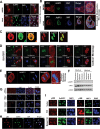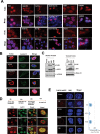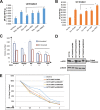Human Apurinic/Apyrimidinic Endonuclease (APE1) Is Acetylated at DNA Damage Sites in Chromatin, and Acetylation Modulates Its DNA Repair Activity
- PMID: 27994014
- PMCID: PMC5335514
- DOI: 10.1128/MCB.00401-16
Human Apurinic/Apyrimidinic Endonuclease (APE1) Is Acetylated at DNA Damage Sites in Chromatin, and Acetylation Modulates Its DNA Repair Activity
Abstract
Apurinic/apyrimidinic (AP) sites, the most frequently formed DNA lesions in the genome, inhibit transcription and block replication. The primary enzyme that repairs AP sites in mammalian cells is the AP endonuclease (APE1), which functions through the base excision repair (BER) pathway. Although the mechanism by which APE1 repairs AP sites in vitro has been extensively investigated, it is largely unknown how APE1 repairs AP sites in cells. Here, we show that APE1 is acetylated (AcAPE1) after binding to the AP sites in chromatin and that AcAPE1 is exclusively present on chromatin throughout the cell cycle. Positive charges of acetylable lysine residues in the N-terminal domain of APE1 are essential for chromatin association. Acetylation-mediated neutralization of the positive charges of the lysine residues in the N-terminal domain of APE1 induces a conformational change; this in turn enhances the AP endonuclease activity of APE1. In the absence of APE1 acetylation, cells accumulated AP sites in the genome and showed higher sensitivity to DNA-damaging agents. Thus, mammalian cells, unlike Saccharomyces cerevisiae or Escherichia coli cells, require acetylation of APE1 for the efficient repair of AP sites and base damage in the genome. Our study reveals that APE1 acetylation is an integral part of the BER pathway for maintaining genomic integrity.
Keywords: AP site; APE1; DNA damage; acetylation; base excision repair; endogenous DNA damage.
Copyright © 2017 Roychoudhury et al.
Figures







Similar articles
-
Base Excision Repair in Mitotic Cells and the Role of Apurinic/Apyrimidinic Endonuclease 1 (APE1) in Post-Mitotic Transcriptional Reactivation of Genes.Int J Mol Sci. 2024 Nov 27;25(23):12735. doi: 10.3390/ijms252312735. Int J Mol Sci. 2024. PMID: 39684445 Free PMC article.
-
Elevated level of acetylation of APE1 in tumor cells modulates DNA damage repair.Oncotarget. 2016 Nov 15;7(46):75197-75209. doi: 10.18632/oncotarget.12113. Oncotarget. 2016. PMID: 27655688 Free PMC article.
-
The role of the N-terminal domain of human apurinic/apyrimidinic endonuclease 1, APE1, in DNA glycosylase stimulation.DNA Repair (Amst). 2018 Apr;64:10-25. doi: 10.1016/j.dnarep.2018.02.001. Epub 2018 Feb 11. DNA Repair (Amst). 2018. PMID: 29475157
-
Fine-tuning of DNA base excision/strand break repair via acetylation.DNA Repair (Amst). 2020 Sep;93:102931. doi: 10.1016/j.dnarep.2020.102931. DNA Repair (Amst). 2020. PMID: 33087268 Free PMC article. Review.
-
Functions of the major abasic endonuclease (APE1) in cell viability and genotoxin resistance.Mutagenesis. 2020 Feb 13;35(1):27-38. doi: 10.1093/mutage/gez046. Mutagenesis. 2020. PMID: 31816044 Free PMC article. Review.
Cited by
-
Interaction between RECQL4 and OGG1 promotes repair of oxidative base lesion 8-oxoG and is regulated by SIRT1 deacetylase.Nucleic Acids Res. 2020 Jul 9;48(12):6530-6546. doi: 10.1093/nar/gkaa392. Nucleic Acids Res. 2020. PMID: 32432680 Free PMC article.
-
Base Excision Repair in Mitotic Cells and the Role of Apurinic/Apyrimidinic Endonuclease 1 (APE1) in Post-Mitotic Transcriptional Reactivation of Genes.Int J Mol Sci. 2024 Nov 27;25(23):12735. doi: 10.3390/ijms252312735. Int J Mol Sci. 2024. PMID: 39684445 Free PMC article.
-
The human AP-endonuclease 1 (APE1) is a DNA G-quadruplex structure binding protein and regulates KRAS expression in pancreatic ductal adenocarcinoma cells.Nucleic Acids Res. 2022 Apr 8;50(6):3394-3412. doi: 10.1093/nar/gkac172. Nucleic Acids Res. 2022. PMID: 35286386 Free PMC article.
-
Genome-Wide Binding Analysis of DNA Repair Protein APE1 in Tumor Cells by ChIP-Seq.Methods Mol Biol. 2023;2701:243-252. doi: 10.1007/978-1-0716-3373-1_16. Methods Mol Biol. 2023. PMID: 37574487
-
Suppression of STAT3 NH2 -terminal domain chemosensitizes medulloblastoma cells by activation of protein inhibitor of activated STAT3 via de-repression by microRNA-21.Mol Carcinog. 2018 Apr;57(4):536-548. doi: 10.1002/mc.22778. Epub 2018 Jan 25. Mol Carcinog. 2018. PMID: 29280516 Free PMC article.
References
Publication types
MeSH terms
Substances
Grants and funding
LinkOut - more resources
Full Text Sources
Other Literature Sources
Molecular Biology Databases
Research Materials
Miscellaneous
